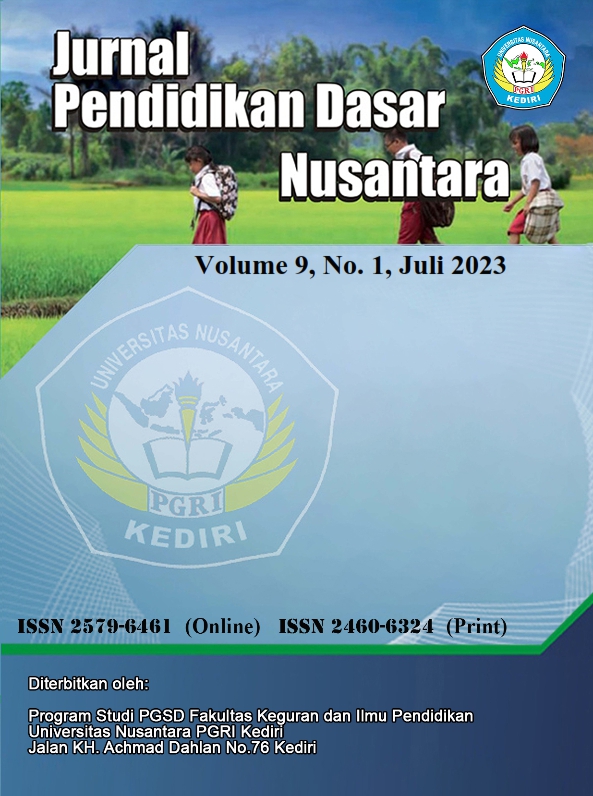Students phobias of mathematics teachers at fourth grade elementary schools
DOI:
https://doi.org/10.29407/jpdn.v9i1.19840Keywords:
phobias, students, math teachers.Abstract
This research was conducted with the background of existing issues faced by students when the mathematics teacher was teaching. The objective of this study is to obtain data related to the causes of mathematics teacher phobia among 4th-grade students in elementary schools. This research method used descriptive qualitative with a case study design and data collection techniques in the form of interviews, observations, and questionnaires conducted on students in 4th-grade elementary schools. The results of the study show that the punishment given by the teacher can make students phobia of the teacher because each student has different conditions. The phobia of students towards math teachers may arise due to the implementation of progressive discipline by the teacher towards each student. Many teachers consider a progressive discipline attitude as one of the most effective ways of educating students to be more disciplined, but this attitude makes a student phobia towards him because his psychology is different from other students. As a result, phobia can be shown directly from students, for example, students are afraid when dealing with math teachers so they will stay away from them as much as possible.
Downloads
References
Anantayudha, E., & Putra, N. (2022). Studi Pustaka Phobia Spesifik ( Zoophobia ) Studi Puskata Phobia Spesifik ( Zoophobia ).
Anita, I. W. (2014). Pengaruh Kecemasan Matematika (Mathematics Anxiety) Terhadap Kemampuan Koneksi Matematis Siswa Smp. Infinity Journal, 3(1), 125. https://doi.org/10.22460/infinity.v3i1.43
Arthur, Y., Addo, S., & Annan, J. (2015). Student Mathematics Interest in Ghana: The Role of Parent Interest, Gender, Basic School Attended and Fear of Basic School Mathematics Teacher. Advances in Research, 5(5), 1–8. https://doi.org/10.9734/air/2015/19889
Cresswel, J. W. (2018). 30 Keterampilan esensial untuk penelitian kualitatif. Pustaka Pelajar.
Eidlin Levy, H., & Rubinsten, O. (2021). Numbers (but not words) make math anxious individuals sweat: Physiological evidence. Biological Psychology, 165(September), 108187. https://doi.org/10.1016/j.biopsycho.2021.108187
F. Okafor, C., & S. Anaduaka, U. (2013). Nigerian School Children and Mathematics Phobia: How the Mathematics Teacher Can Help. American Journal of Educational Research, 1(7), 247–251. https://doi.org/10.12691/education-1-7-5
Garcia, R. (2017). Neurobiology of fear and specific phobias. Learning and Memory, 24(9), 462–471. https://doi.org/10.1101/lm.044115.116
Ismail, Y. (2021). MEMBANGUN SIKAP POSITIF UNTUK MENGHINDARI. 9(2), 134–140.
Khoshaim, H. B. (2020). Mathematics teaching using word-problems: Is it a phobia! International Journal of Instruction, 13(1), 855–868. https://doi.org/10.29333/iji.2020.13155a
Maharani, R., Marsigit, M., & Wijaya, A. (2020). Collaborative learning with scientific approach and multiple intelligence: Its impact toward math learning achievement. Journal of Educational Research, 113(4), 303–316. https://doi.org/10.1080/00220671.2020.1806196
Muh. (2016). Peran Guru Dalam Pengembangan Pembelajaran. Jurnal Inspiratif Pendidikan, 5(2), 274–285. http://journal.uin-alauddin.ac.id/index.php/Inspiratif-Pendidikan/article/view/3480
Muhammad, N. (2019). Multitasking Teacher : Menjadi Guru Yang Mampu Mencerdaskan Siswa dan Sekolah Kelas Sempurna. Araska.
Mulhamah. (2018). Fobia dalam Pembelajaran Matematika di Pendidikan Dasar. El-Midad : Jurnal Jurusan PGMI, 10(1), 1–12. https://journal.uinmataram.ac.id/index.php/elmidad/article/view/501
Onal, N. T., & Buyuk, U. (2021). European Journal of Educational Sciences, 8(1), 15–32. https://doi.org/10.19044/ejes.v8no1a15. http://ejes.eu/wpcontent/uploads/2021/04/2.SCIENCE-EDUCATION-FOR-GIFTED-TUDENTS-OPINIONS-OF-STDENTS-PARENTS-AND-TEACHERS.pdf.
Oppermann, E., & Lazarides, R. (2021). Elementary school teachers’ self-efficacy, student-perceived support and students’ mathematics interest. Teaching and Teacher Education, 103, 103351. https://doi.org/10.1016/j.tate.2021.103351
Purnomo, Y. (2017). Pengaruh Sikap Siswa pada Pelajaran Matematika dan Kemandirian Belajar Siswa terhadap Prestasi Belajar Matematika. JKPM (Jurnal Kajian Pendidikan Matematika), 2(1), 93. https://doi.org/10.30998/jkpm.v2i1.1897
Siregar, N. R. (2017). Persepsi siswa pada pelajaran matematika: studi pendahuluan pada siswa yang menyenangi game. Prosiding Temu Ilmiah X Ikatan Psikologi Perkembangan Indonesia, 224–232.
Sulistyani, N., & Retnawati, H. (2015). Jurnal riset pendidikan matematika. Riset Pendidikan Matematika, 2(2), 197–210.
Warner, S., & Kaur, A. (2021). The Perceptions of Teachers and Students on a 21st Century Mathematics Instructional Model. International Electronic Journal of Mathematics Education, 12(2), 193–215. https://doi.org/10.29333/iejme/609
Windari, R., & Belakang, L. (2015). ( Corporal Punishment ) Pada Anak Di Lingkungan Sekolah. 4(3).
Yin, H., Shi, L., Tam, W. W. Y., & Lu, G. (2020). Linking university mathematics classroom environments to student achievement: The mediation of mathematics beliefs. Studies in Educational Evaluation, 66(December 2019), 100905. https://doi.org/10.1016/j.stueduc.2020.100905
Downloads
Published
Issue
Section
License
Authors who publish with this journal agree to the following terms:
- Copyright on any article is retained by the author(s).
- The author grants the journal, the right of first publication with the work simultaneously licensed under a Creative Commons Attribution License that allows others to share the work with an acknowledgment of the work’s authorship and initial publication in this journal.
- Authors are able to enter into separate, additional contractual arrangements for the non-exclusive distribution of the journal’s published version of the work (e.g., post it to an institutional repository or publish it in a book), with an acknowledgment of its initial publication in this journal.
- Authors are permitted and encouraged to post their work online (e.g., in institutional repositories or on their website) prior to and during the submission process, as it can lead to productive exchanges, as well as earlier and greater citation of published work.
- The article and any associated published material is distributed under the Creative Commons Attribution-ShareAlike 4.0 International License

































